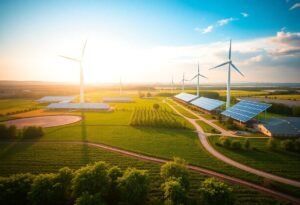Hydropower is a crucial player in the transition towards sustainable energy solutions, capturing the essence of innovation with each flowing river and waterfall. This renewable energy source not only provides electricity but also offers potential in reducing carbon emissions, maintaining ecological balance, and driving technological advancements.
Understanding Hydropower’s Mechanics
Hydropower harnesses the energy from flowing or falling water to generate electricity. This process involves using turbines to convert kinetic energy into mechanical energy, which is then transformed into electrical energy. With continuously growing advancements in turbine design and efficiency, modern hydropower plants can generate electricity with remarkable efficacy, setting a benchmark in the sector of renewable energy technologies. The innovation in hydropower technology includes not just large-scale dams but also smaller projects that integrate well with local ecosystems, ensuring more sustainable practices. Thus, the evolution of hydropower reflects the shift towards smarter, more eco-friendly energy solutions.
The Importance of Innovation in Hydropower
Innovation plays a pivotal role in enhancing the efficiency of hydropower systems. The development of smart grids and real-time data monitoring supports hydropower plants to optimize their performance and infrastructure. Moreover, innovative techniques like pumped storage hydroelectricity allow for energy storage during low-demand periods and release during peak demand, showcasing the flexibility of hydropower in today’s energy landscape. With new technologies emerging, hydropower plants are becoming adaptive, improving their operational capacity while minimizing environmental impact. These technological breakthroughs not only boost productivity but also contribute significantly to energy sustainability, making hydropower a prime focus in future energy discussions.
Hydropower’s Role in Climate Change Mitigation
As global efforts intensify to combat climate change, hydropower emerges as a vital component in reducing greenhouse gas emissions. By replacing fossil fuels with renewable sources like hydropower, countries can significantly lower their carbon footprint. Recent studies have shown that investments in hydropower can yield considerable benefits not just environmentally but economically as well. Innovations aimed at addressing the challenges of hydropower such as sedimentation and ecosystem effects are crucial in ensuring its viability in the future energy mix. Establishing responsible practices while enhancing hydropower’s capacity for climate change mitigation can lead to a sustainable energy future.
Integration with Other Renewable Energy Sources
Hydropower can synergize with other renewable energy sources, creating a balanced energy portfolio that enhances resilience against fluctuations in energy supply. For example, integrating solar and wind energy systems with hydropower increases efficiency, allowing for smoother electricity generation across various conditions. In many regions, hydropower acts as a balancing force in energy grids filled with intermittent sources, enabling utilities to maintain reliability and stability. Such integration facilitates the growth of an interconnected energy landscape where innovation thrives, enriching overall energy solutions.
Global Trends in Hydropower Development
Across the globe, hydropower projects are gaining traction. Countries with extensive water resources are increasingly investing in modern hydropower technologies, underscoring a shift from conventional systems to more dynamic and innovative frameworks. This trend aligns with the global pursuit of sustainable development goals, particularly those targeting affordable clean energy and climate action. Emerging economies are also exploring hydropower potential, backed by technological innovations that promote efficient energy generation, such as micro-hydropower systems tailored for rural electrification. Observing global trends, it is clear that hydropower remains a cornerstone in the future of energy solutions.
The Future of Hydropower Innovations
The future of hydropower innovations is not just about enhancing current technologies; it’s about reimagining how we view water resources in energy production. Innovations such as tidal and wave energy are gaining attention as they complement traditional hydropower, tapping into the vast potentials of ocean currents. Furthermore, research on how to effectively mitigate environmental impacts while maximizing energy output will dictate the next phase of hydropower evolution. As we stand at the precipice of a renewable energy revolution, the innovations rooted in hydropower will remain integral in shaping effective, sustainable solutions for tomorrow’s energy needs.
Disclaimer: The information provided in this article is for informational purposes only and should not be considered as professional or expert advice.





















